D-sharp ionian mode
The Solution below shows the D-sharp ionian mode notes on the piano, treble clef and bass clef.
The Lesson steps then explain how to identify the mode note interval positions, choose note names and scale degree names.
For a quick summary of this topic, have a look at Mode.
| Key | C | C# | Db | D | [D#] | Eb | E | E# | Fb | F | F# | Gb | G | G# | Ab | A | A# | Bb | B | B# | Cb |
|---|
Solution - 2 parts
1. D-sharp ionian mode
The D-sharp ionian mode has 5 sharps, 2 double-sharps.
| Note no. | Note interval | Note name |
|---|---|---|
| 1 | tonic | The 1st note of the D-sharp ionian mode is D# |
| 2 | D#-maj-2nd | The 2nd note of the D-sharp ionian mode is E# |
| 3 | D#-maj-3rd | The 3rd note of the D-sharp ionian mode is F## |
| 4 | D#-perf-4th | The 4th note of the D-sharp ionian mode is G# |
| 5 | D#-perf-5th | The 5th note of the D-sharp ionian mode is A# |
| 6 | D#-maj-6th | The 6th note of the D-sharp ionian mode is B# |
| 7 | D#-maj-7th | The 7th note of the D-sharp ionian mode is C## |
| 8 | D#-perf-8th | The 8th note of the D-sharp ionian mode is D# |
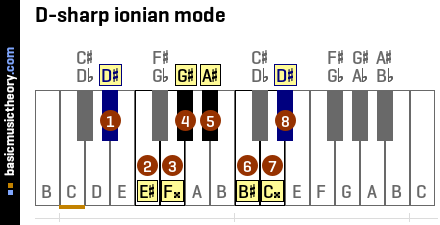
Middle C (midi note 60) is shown with an orange line under the 2nd note on the piano diagram.
These note names are shown below on the treble clef followed by the bass clef.


| Note no. | Degree name |
|---|---|
| 1 | D# is the tonic of the D-sharp ionian mode |
| 2 | E# is the supertonic of the D-sharp ionian mode |
| 3 | F## is the mediant of the D-sharp ionian mode |
| 4 | G# is the subdominant of the D-sharp ionian mode |
| 5 | A# is the dominant of the D-sharp ionian mode |
| 6 | B# is the submediant of the D-sharp ionian mode |
| 7 | C## is the leading tone of the D-sharp ionian mode |
| 8 | D# is the octave of the D-sharp ionian mode |
| Bass Clef: | Midi | MP3 | Treble Clef: | Midi | MP3 |
2. D-sharp ionian mode descending
| No. | 1 | 2 | 3 | 4 | 5 | 6 | 7 |
|---|---|---|---|---|---|---|---|
| Note | C## | B# | A# | G# | F## | E# | D# |
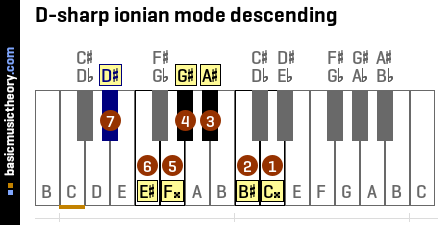


| Bass Clef: | Midi | MP3 | Treble Clef: | Midi | MP3 |
Lesson steps
1. Piano key note names
The white keys are named using the alphabetic letters A, B, C, D, E, F, and G, which is a pattern that repeats up the piano keyboard.
Every white or black key could have a flat(b) or sharp(#) accidental name, depending on how that note is used. In a later step, if sharp or flat notes are used, the exact accidental names will be chosen.
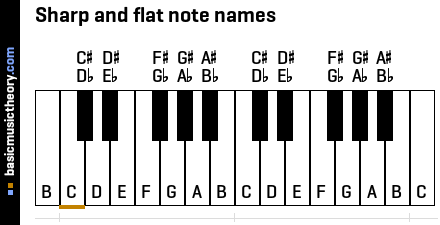
The audio files below play every note shown on the piano above, so middle C (marked with an orange line at the bottom) is the 2nd note heard.
| Bass Clef: | Midi | MP3 | Treble Clef: | Midi | MP3 |
2. D-sharp ionian mode tonic note and one octave of notes
The numbered notes are those that might be used when building this mode.
The D-sharp ionian mode starts on note D-sharp.
Since this mode begins with note D#, it is certain that notes 1 and 13 will be used in this mode.
Note 1 is the tonic note - the starting note - D#, and note 13 is the same note name but one octave higher.
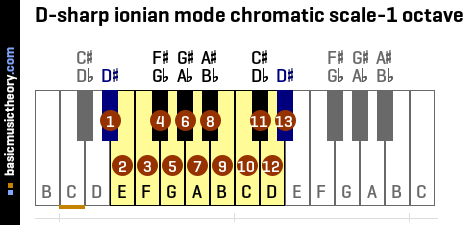
| No. | 1 | 2 | 3 | 4 | 5 | 6 | 7 | 8 | 9 | 10 | 11 | 12 | 13 |
|---|---|---|---|---|---|---|---|---|---|---|---|---|---|
| Note | D# | E | F | F# / Gb | G | G# / Ab | A | A# / Bb | B | C | C# / Db | D | D# |
| Bass Clef: | Midi | MP3 | Treble Clef: | Midi | MP3 |
3. D-sharp ionian mode note interval positions
In their simplest / untransposed form, modes do not contain any sharp or flat notes.
This can be seen by looking at the Mode table showing all mode names with only white / natural notes used.
The ionian mode uses the W-W-H-W-W-W-H note counting rule to identify the note positions of 7 natural white notes starting from note C.
The D-sharp ionian mode re-uses this mode counting pattern, but starts from note D# instead.
To count up a Whole tone, count up by two physical piano keys, either white or black.
To count up a Half-tone (semitone), count up from the last note up by one physical piano key, either white or black.
The tonic note (shown as *) is the starting point and is always the 1st note in the mode.
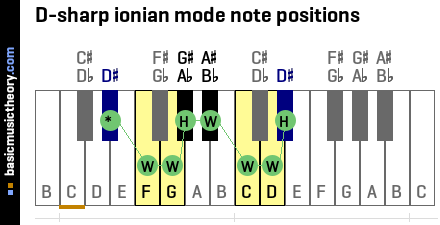
| No. | 1 | 2 | 3 | 4 | 5 | 6 | 7 | 8 |
|---|---|---|---|---|---|---|---|---|
| Note | D# | F | G | G# / Ab | A# / Bb | C | D | D# |
One or more note in this mode has a sharp or flat, which means that this mode has been transposed to another key.
| Bass Clef: | Midi | MP3 | Treble Clef: | Midi | MP3 |
4. D-sharp ionian mode notes
The 7 unique notes in a mode need to be named such that each letter from A to G is used once only - and so each note name is either a natural white name(A..G) , a sharp(eg. F-sharp) or a flat(eg. G-flat).
The rule ensures that every position of a staff is used once and once only - whether that position be a note in a space, or a note on a line.
This is needed to ensure that when it comes to writing the mode notes on a musical staff (eg. a treble or bass clef), there is no possibility of having 2 G-type notes, for example, with one of the notes needing an accidental next to it on the staff (a sharp, flat or natural symbol).
Applying the rule below ensures that when accidental adjustment symbols are added next to staff notes as part of composing music based on that mode, these accidentals will indicate that the adjusted note is not in that mode.
To apply this rule, firstly list the white key names starting from the tonic, which are shown the white column below.
Then list the 7 notes in the mode so far, shown in the next column.
For each of the 7 notes, look across and try to find the white note name in the mode note name.
If the natural white note can be found in the mode note, the mode note is written in the Match? column.
The 8th note - the octave note, will have the same name as the first note, the tonic note.
| No. | White | Mode Note | Match? |
|---|---|---|---|
| 1 | D | D# | D# |
| 2 | E | F | m |
| 3 | F | G | m |
| 4 | G | G# / Ab | G# |
| 5 | A | A# / Bb | A# |
| 6 | B | C | m |
| 7 | C | D | m |
| 8 | D | D# | D# |
For this mode, there are 4 mismatches (Shown as m in the Match? column), whose note names will need to be adjusted in the next step.
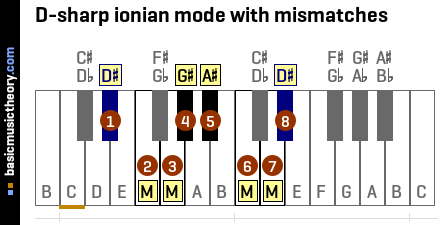
5. Make the D-sharp ionian mode note name adjustments
The adjustment explanation below needs to be applied to every mismatch m in the above table. The first mismatch is used as an example.
The match fails when trying to find a E -type of mode note, because either this type of note does not exist in this mode, or it exists but is in the wrong position number / table row for this match.
But music theory rules allow the name of any note to be sharpened or flattened, even white note names, so since a E-type of note name is needed, the real mode note F will be renamed to E#.
Of course, even though the note is named E#, when it comes to playing the note on an instrument, the real note F is really played.
The adjustments done in this step do not change the pitch / sound of the note, only the name of the note.
After doing the adjustments to all mistmatches, all letters A..G will have been used for this mode, and no rules have been broken.
Note that sometimes it is necessary to adjust the note name two semitones / half-tones forward or back, which will result in an adjusted name containing a double-sharp or double-flat.

| No. | 1 | 2 | 3 | 4 | 5 | 6 | 7 | 8 |
|---|---|---|---|---|---|---|---|---|
| Note | D# | E# | F## | G# | A# | B# | C## | D# |
6. D-sharp ionian mode descending
For all modes, the notes names when descending are just the reverse of the ascending names.
So assuming octave note 8 has been played in the step above, the notes now descend back to the tonic.

| No. | 1 | 2 | 3 | 4 | 5 | 6 | 7 |
|---|---|---|---|---|---|---|---|
| Note | C## | B# | A# | G# | F## | E# | D# |
| Bass Clef: | Midi | MP3 | Treble Clef: | Midi | MP3 |
7. D-sharp ionian mode degrees
Scale degree names 1,2,3,4,5,6, and 8 below are always the same for all modes (ie. 1st note is always tonic, 2nd is supertonic etc.) , but obviously the note names will be different for each mode / key combination.
In this mode, the 7th note is called the leading note or leading tone because the sound of the 7th note feels like it wants to resolve and finish at the octave note, when all mode notes are played in sequence.
It does this because in this mode, the 7th note is only 1 semitone / half-tone away from the 8th note - the octave note. The lydian mode shares the same property - it only has one semitone / half-tone between the 7th and 8th notes.
In contrast, all other modes, including for example the phrygian mode, have a whole tone (two semitones, two notes on the piano keyboard) between the 7th and 8th notes, and the 7th note does not lean towards the 8th note in the same way. For these other modes, the 7th note is called the subtonic.
| Note no. | Degree name |
|---|---|
| 1 | D# is the tonic of the D-sharp ionian mode |
| 2 | E# is the supertonic of the D-sharp ionian mode |
| 3 | F## is the mediant of the D-sharp ionian mode |
| 4 | G# is the subdominant of the D-sharp ionian mode |
| 5 | A# is the dominant of the D-sharp ionian mode |
| 6 | B# is the submediant of the D-sharp ionian mode |
| 7 | C## is the leading tone of the D-sharp ionian mode |
| 8 | D# is the octave of the D-sharp ionian mode |
| Key | C | C# | Db | D | [D#] | Eb | E | E# | Fb | F | F# | Gb | G | G# | Ab | A | A# | Bb | B | B# | Cb |
|---|